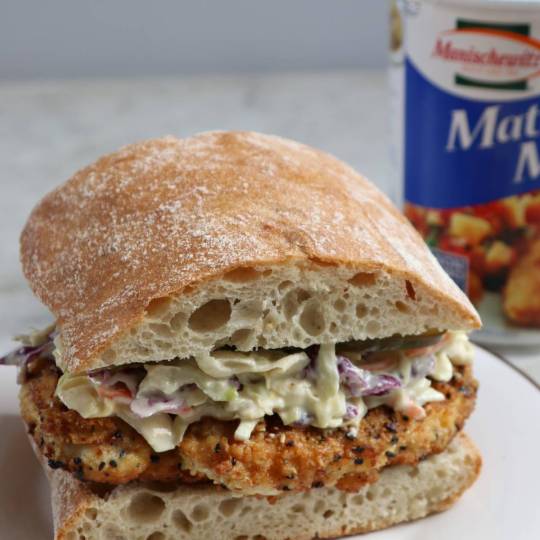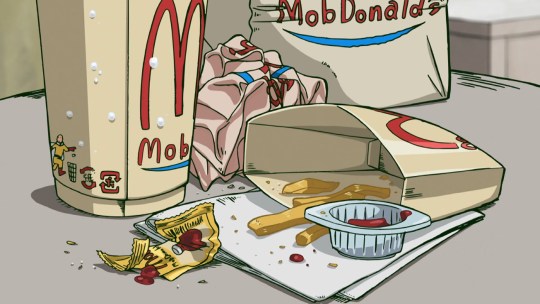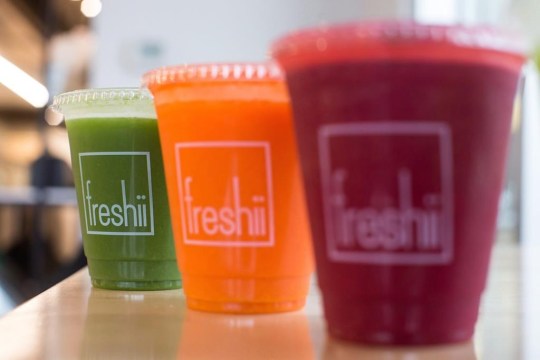This is my food blog for MLLC 270: Global Food Studies.
Don't wanna be here? Send us removal request.
Text
The Last Supper
This is my final post, the final frontier, where I will answer the question, “Did the experience of journaling your food/drink intake impact your choices?” Most of these posts focused on my past experiences with food, because I have been eating less recently. Yesterday, I cooked a plate of egg, rice, beans, and avocado, similar to this one I have made before, which includes shoots:

I could barely eat it, and I threw it away. So all I ate yesterday was a protein bar, a cup of tea, and a few crackers. I haven’t finished one actual meal this week, so what was there to share?
I do not think this is funny. I never knew how complicated my relationship was with food until I began this blog. Thinking about food makes me homesick. I currently live in East Boston, so there’s plenty of Hispanic food, but I’m not Peruvian, Mexican, or Salvadorian.
Thinking of this blog, I brought up limber (“Puerto Rican popsicle”/ice cream) to my best friend a couple of days ago. My friend told me he would buy limber from neighbors and I told him I would buy it from the bodega. “Real limber?” he asked. He liked cherry limber, and "real" limber meant limber with pieces of fruit in it.
“Real limber,” I said, because my favorite is limber de coco with actual coconut flakes. My grandmother would buy them for me, toting shiny black bags full of plastic cups back from the bodega. There is nothing better than this dessert on a hot, humid day. I miss it.

This blog has caused me to rethink my eating habits. Before the pandemic, I used to drink an excessive amount of milkshakes, and I wondered if they had become a clutch/comfort. Because of this blog, I’m still looking at things differently. Did I like Whoppers because they were convenient? Do I like healthy food because it defies the family heritage and morals I was brought up with? Do I enjoy Puerto Rican food because it’s part of my heritage and generates happy memories, or am I just desperately attempting to prove to the world that I’m Puerto Rican because I know what “tostones” means?
I don’t know the answers to these questions. And I can’t say journalling my eating and cooking habits has changed them. But maybe I will try to make Japanese-inspired recipes more, something separate from the Hispanic cultures and memories I am tied to. As an adult, I can cook…whatever I want. And maybe, one day, I will.
0 notes
Text
"Going Kosher"

There have been times that I’ve been temporarily vegetarian or vegan for health reasons. There have been times where I ate pie for breakfast, lunch, and dinner, and there have been times where I scrupulously counted my calories. But none of these times are as memorable as the time that I, an atheist, began eating almost completely kosher.
From 2019-2020, I attended Clark University. I did not enjoy the food. I watched a girl pick a fry out of the bin with her fingers. I watched flies buzz over the desserts. And I was trying to avoid milk, and meat, and I was taking “Narratives of the Hebrew Bible.” So my mind led me to venture to the back of the cafeteria to where the kosher chefs prepared their meals.
The chefs served you and they were always nice. There was barely anything to choose from, which made it easier to choose. There were two meals served everyday, except Shabbat, which was perfect for me. And they never served dairy and meat at the same time. Win-win.
That kosher food was some of the best food I’ve ever had. I was only at Clark for six months because of the pandemic, but I would eat kosher almost every single day. There is limited information about the kitchen online, but the Clark University website reads, “Some Clarkie favorites include meatballs, chicken sandwich, pastrami, and beef stew.” I did enjoy their meatball grinders and their delicious pastrami. Sometimes they had a chocolate pudding dessert. On Sunday brunches, they had breakfast pies, which I enjoyed. But my favorite dish from them would have to be their homemade slaw. I enjoyed it with or in their sandwiches. It had a dill taste; a lot of their food reminded me of the Mediterranean diet.
I am glad that I had this experience of trying this food. If I never went to Clark, I don’t think I would have ever eaten so much kosher food. Convenience, health, and taste factored into why I ate from the kosher kitchen. If the kitchen wasn’t serving, I wouldn’t even go to the dining hall. I can’t even remember the exact dishes and ingredients, but the happiness I felt while eating was so potent that I will always remember the kosher kitchen pleasantly. It was a respite for me. I was finally able to eat something, and it tasted good.
0 notes
Text
Seeing My Childhood in a Silver "Wendy's" Wrapper

A few years ago, I was at Wendy’s with one of my friends, sitting at a table and unwrapping a spicy chicken sandwich. My friend told me that she'd never eaten at Wendy's before, and I said I always went to Wendy’s during my childhood.
“You've eaten at so many places,” she said. “You’re so lucky.”
Yes, I frequented many fast food establishments or chain restaurants as a kid. McDonald’s, Burger King, Wendy’s, Popeye’s, Boston Market, Subway, Taco Bell, Dunkin' Donuts, Hometown Buffet, Pizza Hut, Friendly’s, IHOP, Denny’s, and Little Caesar’s were just some of the places I ate from. There were local Chinese restaurants and pizzerias, too. When I was a kid and my doctor told me I was overweight, my father said, “It's because you ate fast food."
The reason I ate so much fast food is because my parents were always fighting. One of my strangest memories is when my father threw a Wendy’s salad at my stepmother. My father would also break dishes and pans, so we had to eat something. Sometime after my parents divorced, my father and I ate Whoppers for dinner three days straight, which disgusts me now that I think about it. But my father and I were always too tired, or fighting, to cook. He was never taught to cook, because he was a man, and my mother never taught me how to cook before she left. I remember after one night of fighting, he brought me to Friendly’s, got me a milkshake, and tried to take a picture of me to prove that I was happy. We didn't dine. We ate.
It’s strange to look back on your childhood through the lens of food. My mother would give us small portions so she could reuse the same food for five days, so we were eating microwaved rice and beans for five days straight. My relatives, on both sides of the family, said my mom did not feed us enough. At least I never went hungry. Looking back on those years, I don’t feel lucky. Food can be used to unite people, but it can tell a story of disunion, too. I’m suddenly reminded of our lecture “The British Empire and the Atlantic Slave Trade,” when the English, in an act of defiance, called French fries “Freedom fries.” It’s indicative of division and I think that’s one of the things I perceive when I reflect on what I ate as a child. What we eat is connected to our identities. The bad times, and the bad food I ate during them, will always be a part of me.
0 notes
Text
An Unexpected Inspiration
I am not really someone who tries new foods, but something inspires me at times: anime. Most anime series take place in Japan and obviously food is a big part of any culture, Japan being no exception. Artists will dedicate entire storyboard panels to the illustration of these meals.
One anime that inspired me to cook and try new foods from around the globe is Mob Psycho 100. The show centers around a character and his mentor. To resolve an argument or celebrate the end of a job, the two will often go out for ramen. In the movie Eat Drink Man Woman, Jian-Chang says, “We communicate by eating” (1:28:30). These two characters in Mob don’t talk about their feelings, but returning to that routine of eating together communicates that they have reached a resolution and cements their bond.

I was inspired by this show and others like it to experiment with ramen. This is what one of my experiments looks like. The ramen had corn, spinach, potstickers, egg, and furikake.

The characters also eat takoyaki, which are octopus balls coated with batter and topped with tempura scraps, pickled ginger, and green onion. I decided to try this because of the show, too, and I tried it on my 21st birthday, along with a bottle of soju. (This is Korean alcohol, which I heard about through a friend, but I recently saw it in another anime series.) I liked the takoyaki. I know it might seem silly to try food just because I’ve seen it in an anime series, but the frequent images of food really make you think “What does that even taste like?”

One of the subjects we’ve discussed in class is how diets are partially dependent on convenience. People will eat what is around them, because it is accessible. This reminded me of a series called Free!, where one of the characters is obsessed with mackerel. It makes sense that mackerel would be a convenient dish to make, as the series takes place in a seaside town.

1 note
·
View note
Text
My "Juicy" Restaurant Career

Working in a restaurant definitely changes your perspective on food and the restaurant industry. I worked at a “healthy fast food restaurant” from May 2018-January 2019 and December 2019-March 2020. We closed due to the pandemic, but honestly, we didn’t have a lot of customers and we never met our sales goals. I also worked at a Starbucks café from April-August 2019.
Working at a restaurant exposes you to how disgusting the restaurant industry is. I will never forget opening a box of ginger that was so moldy that it was white. My manager told me to “just scrape it off” so I could make the miso dressing. I guess that seems fine to people, but I don’t like eating food that I know has been a bit moldy. We also had a few complaints of customers finding flies or hair in their food, but there was no way to determine if those concerns were legitimate.
The work at the “healthy fast food restaurant” was labor-intensive because we were required to make our own dressings and juices. We had a juicing machine and those machines are notoriously expensive for a reason. We had to make four different types of juices that required different ingredients such as apples, ginger, celery, and carrots. These juices also went “bad” after two days, so we had to make them every two days, even though people rarely bought them. The juices were difficult to make because some of the ingredients we used barely exuded juice. You can get juice from an apple or a piece of celery, but... a carrot? A piece of ginger?! Juicing was also a long process because you had to thoroughly clean the juicer after every juice.
Making the dressings was a lengthy process as well. It was easier when we had immersion (hand) blenders, but when I returned to the restaurant in December 2019, I found out that much of our equipment was broken and it was never replaced. We no longer had timers and I don’t believe we had thermometers. We no longer had a manual can opener; we had one that was attached to the table and required us to puncture the can. The worst thing: we didn’t have the hand blenders. Instead, we had to mix the dressings in blenders that we used for smoothies. However, those blenders were always being used for smoothies, so it was hard to access them for the dressings, and the blenders could only hold about 16-20 ounces of liquid. Each dressing was about 3.5 quarts in volume, and there were multiple dressings, like caesar, ginger miso, and roasted red pepper.
There’s definitely more I could say about this place, but I’ll end with this: I think one of the reasons I hate cooking was because I would spend hours chopping carrots and tomatoes almost every single day in the summer.
0 notes
Text
The Goya Controversy

Because I have white skin, I’m often rejected by the Hispanic community. Regardless, my great-grandmothers migrated to the United States from Puerto Rico, making me a Boricua—a Puerto Rican. If you are a Boricua, or a Hispanic/Latino, you know about Goya. Goya is a brand that sells the products found in the “Mexican” aisle of your grocery store. (I could talk about how any Spanish food is usually assigned to the “Mexican” section, but I’ll save that for another day.) These products include canned beans and vegetables, rice, sweets like wafers and Marias (a traditional Spanish cookie), and seasonings. Two extremely popular seasonings are that of sazón and adobo. These seasonings are so universally known by our community that they can be “meme’d.” This is one I’ve seen before.

So, Goya made our seasonings, and we bought their products, swearing by their sazón and adobo and sofrito. It was a healthy, MSG-flavored, beneficial relationship for both parties. Until 2020—the United States’ presidential elections. Robert Unanue, CEO of Goya Foods, said that the nation was “blessed” to have Donald Trump as president. After the Capitol riot in January 2021, Unanue claimed that Trump was our “real” president, perpetuating the ideology that initiated the riots in the first place.
Considering that Donald Trump said that Mexicans were drug dealers, criminals, and rapists, he is disliked by a substantial portion of the community. It cannot be ignored that there are “Latinos for Trump” and that Trump is a hit with Latinos who want stronger immigration policies. But some Latinos no longer wanted to line Unanue’s pockets, as he vocally advocates for someone who said, “When Mexico sends their people, they’re not sending the best.”
And that’s how the boycott against Goya began. There were a barrage of posts about buying from Badia, who also produces the same seasonings, or making your seasonings at home. I only knew this when I did research for this blog post, but apparently people were posting videos where they were dumping their seasonings down the drain. I used to snack on Marias and now I turn away from them at the bodega. I don’t buy Goya products anymore. People might have forgotten 2020 but Unanue’s continued support in 2021 reminded them. However, the brand is reportedly fairing greatly; it will never be replaced.
Because Goya’s products are such a cultural staple in our community. They’ve become part of the Latino identity. I know two people nicknamed "Adobo." I remember eating rice and beans for breakfast and my father scolding me because of the MSG in sazón. If we’ve learned anything from the controversy, it’s that food isn’t just food. What we eat defines us—our values, our backgrounds.
Interestingly, Goya is a Hispanic-owned company. There’s always going to be people who deny where they’re from, who exercise self-hatred in an attempt at assimilation. Or...I'm looking at this too deeply, and it's just seasoning. At the end of the day, people will express their opinions with their wallets. "Put your money where your mouth is," and so on, and so forth.
0 notes
Text
Off to the Market

Growing up, I was rarely introduced to new foods. But my father was interested in farmer’s markets and vendors. He would wake up early on Saturdays and go to a farmer’s market near the airport. We would buy fresh brown eggs and pollen. My father would sprinkle the pollen into pancakes because he thought it possessed some type of health benefit. On the weekends, he would also drive my mother and I to different Connecticut markets where you could pick fresh fruits as well as buy fresh eggs and vegetables. We liked the strawberries because they were much smaller than the strawberries in the store; they didn’t have as many added chemicals. I later introduced my partner to one of the orchards, where we picked peaches and apples.
Now that I live in Boston, I have the opportunity to consume more local foods. When I discovered Boston Public Market, I fell in love. My partner (the cook) and I moved closer to the market, which makes it even better! Many of the vendors accept EBT, which makes the farm fresh food affordable. There is one vendor that I shop from, but I can’t find it on the Internet anymore, so maybe they have closed. They sold fresh cuts of meat and fresh eggs. We would also purchase seafood from Red’s Best. My favorite was the salmon burgers; I believe they would add kale and onion to the burgers. The first time my partner tried to cook them, the heat didn’t penetrate the patty, so she broke it open. We would eat the pieces of salmon with buttered noodles. It is one of my favorite meals of hers; the salmon is soft and a little salty.
The BPM vendor that I frequent the most is Mother Juice. Their main store is located in Cambridge, Massachusetts. They make bowls, salads, juices, and smoothies. My favorite item from them is their bowls. I usually order their Overnight Oats bowl, which they describe as "rolled oats soaked in almond milk blended with banana, dates, cinnamon & sea salt; topped with local granola, sun butter, fresh berries and coconut flakes.” I’ve attached a picture of their Pumpkin Pie Bowl, which I also enjoyed; their description of the bowl reads, “Rolled oats soaked in a blend of banana, pumpkin spice, turmeric, dates, and coconut milk. Topped with quinoa, cashew cream cheese, banana, mango, pecans & pumpkin seeds.” On their website, they state "We source our ingredients ... from New England farms, artisan makers, and the highest quality distributors.” I like that they use local ingredients because I know where my food is coming from. I also like to eat “healthy” and these bowls contain a lot of healthful ingredients, although they do have a lot of sugar, which is not good for you.
0 notes
Text
Food and Mood

I could not start this blog without saying that I may have disordered eating. My eating is highly connected to my mood. I am also taking medication which causes appetite loss, and I hate cooking so that doesn’t make it any better.
When I was a child, my mother would cook some Puerto Rican dishes—arroz con gandules y chuletas (rice, pigeon peas, and pork chops) or arroz con salchichas (rice with Vienna sausages). After my parents divorced and no one was really around, I usually ate frozen food: frozen pizzas, frozen vegetables, and frozen fries. I would eat trays of pie on the school bus.
When I went to boarding school, the food was completely different to me. I was introduced to jasmine rice, stuffed peppers, and salmon. I had never eaten salmon or haddock before I went to boarding school. I wasn't used to eating that kind of food, which was admittedly healthier, and I found much of it to be gross. If I’ve ever had an eating disorder, it was at boarding school. Once, I passed out and hit my head on the bathtub, waking me up again.
After high school I began living by myself, and my fridge was empty because I was poor, tired, and always working. If I had the energy, I would make myself “Puerto Rican salad” (iceberg lettuce and tomatoes), quesadillas with beans and sour cream, ramen, canned soup, Lean Cuisines, oatmeal (with water), or baked potatoes.
Sometimes I looked sick. After meeting my partner, I gained the weight back.
Both mental health and circumstances have affected my diet over the years. When I’m happy, I eat more, but when I’m not, I’m almost repelled by the thought of eating. In “Food: The Key Concepts,” Warren Belasco writes that “food serves to express personal and group identities...” He establishes that our identities factor into what and how we eat. What do my eating or food patterns say about me? How do they factor into the establishment of my personal identity? I am 21, and for most of my life, what and how often I ate was determined by my family and my school. Now, I am dependent on my partner to make my meals. This post has caused me to reflect upon the fact that there is no excuse—I control what I eat, and my eating should not be determined by anyone else. I shouldn’t put my diet into the hands of someone else. It is my responsibility to take care of myself, but it is easier said than done.
0 notes